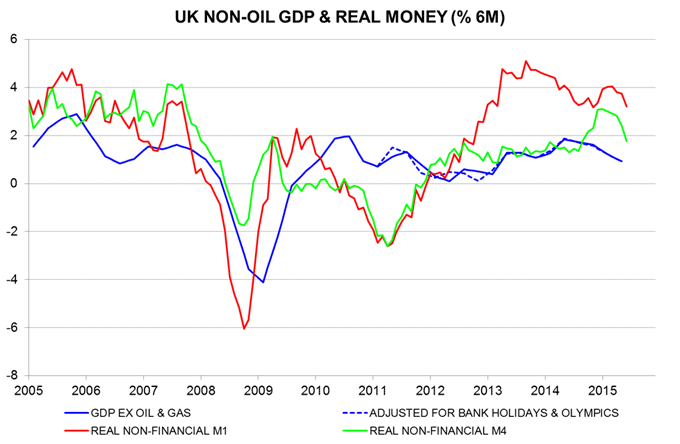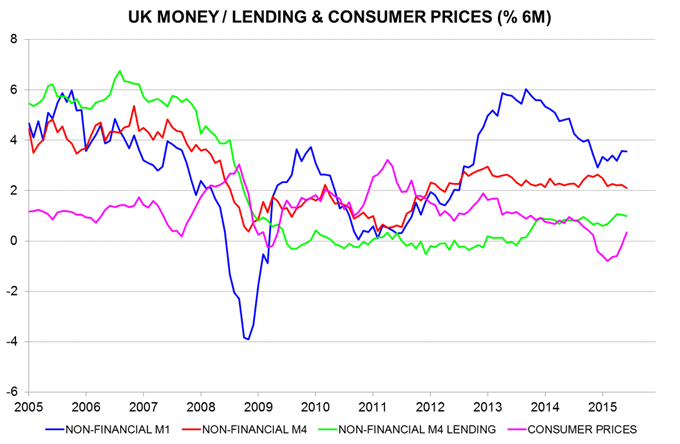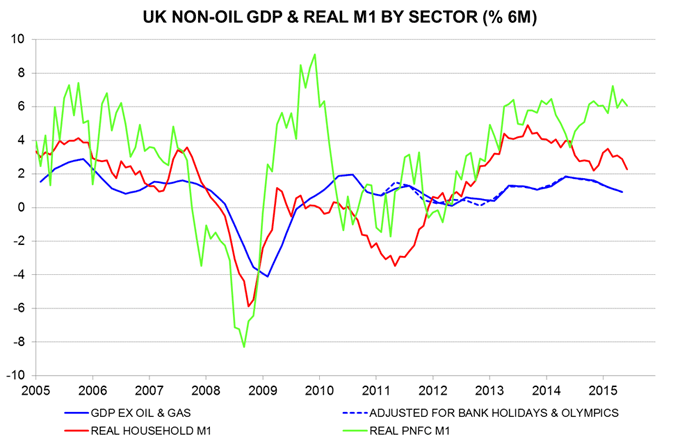Entries from July 1, 2015 - July 31, 2015
Global growth: business surveys supporting H2 pick-up
Previous posts suggested that global economic growth would revive from mid-2015, reflecting stronger developed-world demand following a pick-up in real money expansion in late 2014 / early 2015. Incoming business survey results are consistent with this forecast. The first chart shows a selection of developed-country manufacturing survey indicators for which a July reading is available. Four of the five have recovered significantly since the spring, with all now above their average levels since 2010.
The obvious concern is that a revival in developed-world demand will be offset by further weakness in China and other emerging economies. The Markit Chinese PMI manufacturing new orders index fell sharply in July but is above previous lows over 2011-14, when industrial output was rising more strongly than recently – second chart. The survey responses may have been influenced by recent stock market turmoil; the equity analysts’ earnings revisions ratio was stable in July. Official PMI survey results, based on a larger sample, will be released shortly.
Monetary trends do not suggest a deterioration in emerging-world economic prospects. Six-month real narrow money growth in the “E7” large economies, indeed, has firmed recently, while G7 expansion continues to moderate from its February peak; the G7 / E7 gap is at a nine-month low – third chart*. Reflecting the G7 slowdown, the preferred scenario here is that stronger global economic growth during the second half will give way to another moderation from early 2016 – see previous post.
*E7 June datapoint estimated based on data for five countries.



UK money trends still solid
UK money / inflation trends suggest that economic growth will firm during the second half of 2015 before moderating again in early 2016.
The best monetary leading indicator of the economy is “real non-financial M1”, defined as the stock of notes / coin and sight deposits held by households and private non-financial corporations deflated by consumer prices. This measure gave advance warning of the 2008-09 recession, the 2011-12 “double dip” scare and the 2013 growth surge – see first chart.
It also correctly signalled the recent modest economic slowdown. Six-month growth of real non-financial M1 peaked in September 2013, while the two-quarter increase in non-oil GDP topped out in the second quarter of 2014 – the difference of about eight months is in line with the Friedman / Schwarz finding of a typical lead time from money to output of between six and nine months*.
The two-quarter non-oil GDP change continued to moderate in the second quarter but is probably bottoming. Six-month real non-financial M1 growth stabilised between August and December 2014 before strengthening in early 2015, peaking in March. This suggests that two-quarter GDP expansion will rise to another top in either the fourth quarter of 2015 or the first quarter of 2016.
Quarterly GDP rises in the third and fourth quarters may exceed 0.6%, satisfying one of Bank of England Governor Mark Carney’s latest three conditions for policy tightening (the others being a pick-up in unit labour cost growth and a recovery in “core” inflation).
The fall in real non-financial M1 growth since March may not signal a significant economic slowdown from early 2016, for two reasons. First, the decline reflects a recovery in six-month consumer price inflation rather than lower nominal money expansion – second chart. Secondly, real corporate M1 continues rise fast and is better correlated with future economic performance than household M1 – third chart.
*A study here of G7 data since the 1960s found an average lead time between real narrow money and industrial output of nine months (further details on request).



Eurozone money trends still solid
Eurozone monetary trends continue to suggest a positive economic outlook. Narrow money M1 rose by a strong 0.9% in June, with the broader M3 measure up by 0.3%. Loans to the private sector, adjusted for sales and securitisation, were unchanged on the month but this reflected repayments by financial companies – loans to households and non-financial corporations increased by 0.2%.
Six-month M1 growth rose to 6.6%, or 13.6% annualised, the highest since February 2009 – see first chart. The 2008-09 pick-up preceded solid economic expansion, with GDP rising by 2.2% between the second quarters of 2009 and 2010. Growth of real M1 (i.e. deflated by consumer prices) has moved sideways since January as inflation has recovered but is significantly faster than in most other economies – second chart.
While money trends remain expansionary, there is little in the data to suggest a positive impact from QE. The monthly rise in M3 averaged 0.4% over March-June, down from 0.5% over November-February, before QE started. This accords with experience in the US, UK and Japan, discussed in previous posts. QE effects on broad money are small because of offsetting changes in the other “credit counterparts”: for example, banks have switched from buying to selling government securities since QE started, with sales of €36 billion over March-June.
Country detail shows solid growth of real M1 deposits across the big four economies, with France leading and Italy lagging – third chart. Also notable are continued strength in Ireland and a sharp rebound in Portugal, consistent with a lack of contagion from Greece’s self-imposed crisis – fourth chart.




EM equities: get ready to buy?
Emerging market equities have underperformed developed markets by a further 5.5% so far in 2015, according to MSCI indices. The price to book ratio of the MSCI Emerging Markets index stood at 1.55 at end-June versus 2.24 for the MSCI World index of developed markets – a 31% discount, the largest since 2003. Is it time to increase EM exposure?
Emerging equities have lagged since 2010, when six-month real narrow money growth in the “E7” large economies fell sharply to below its 1996-2009 average of 5.5% (not annualised) – see first chart. This slowdown signalled that economic prospects were deteriorating at a time of exuberant sentiment towards EM – the MSCI EM index reached a peak price to book premium to MSCI World of 18% in 2010 while 98% of global fund managers polled by Merrill Lynch claimed to be overweight.
E7 real money growth recovered modestly in 2012 but remained below the historical norm and fell away again in 2013-14. Fund managers, meanwhile, have filed for divorce – a net 20% are now underweight, representing a 1.9 standard deviation shortfall from the long-run average, according to ML.
Previous bouts of underperformance in the late 1990s and late 2000s were also associated with a sharp decline in real money growth to below average – first chart.
A simplistic strategy that would have worked well would have been to invest in emerging markets when E7 six-month real money growth was above 4% and had not fallen by more than 2 percentage points over the prior six months but revert to developed markets if either of these conditions was no longer met. Such a strategy would have outperformed a passive investment in EM by a cumulative 176% between end-1995 and end-2014, or 5.5% per annum – first chart.
E7 six-month real money growth has recovered recently but remains weak, at an estimated 2% in June. It may be advisable to await further improvement before increasing EM exposure.
How likely is a further pick-up? The second chart shows real money trends in the individual economies. The E7 aggregate has been suppressed by significant real money contraction in Russia and Brazil; a recovery in these two economies, where interest rates have respectively fallen and stabilised, could be sufficient to lift the E7 measure to the 4% “buy” level.


Chinese "true" M1 growth still subdued
The PBOC has released additional monetary data for June, allowing calculation of the “true” M1 measure monitored here. To recap, M1 is conventionally defined as currency in circulation plus demand deposits. Chinese M1, however, includes only demand deposits of corporations – a major deficiency at a time when policy is attempting to promote consumption- rather than investment-led growth. True M1 corrects this omission by adding a separate series for household demand deposits to the official M1 measure.
The six-month change in real true M1 (i.e. deflated by consumer prices) slumped in late 2014, warning of economic weakness in 2015 – see first chart. Growth has recovered but is no higher than a year ago and below that of real official M1 (and M2). The suggestion is that recent policy easing has been only partially effective and economic expansion, while reviving, will remain below par.
Corporate demand deposits, including deposits of state bodies, are rising solidly in real terms but household deposits continue to stagnate – second chart. A near-term economic pick-up based on higher corporate / state spending is unlikely to be sustained without consumer follow-through.


Greek mattress stash up to 30% of GDP
The stock of banknotes put into circulation by the Bank of Greece rose by a further €5.3 billion in June to a record €50.5 billion – see chart. The central bank’s liability to the rest of the Eurosystem related to the supply of notes is now €22.8 billion, on top of a €107.7 billion TARGET2 deficit.
The stock of notes is equivalent to 30% of forecast GDP in 2015 and 37% of bank deposits of Eurozone residents in Greek banks at end-May. For comparison, the Eurozone-wide stock equals 10% of GDP and 9% of bank deposits.
The ECB has accommodated a huge shift in Greek liquidity preference caused by the confidence-wrecking manoeuvres of the former finance minister and associated “Grexit” fears. His claim of deliberate “liquidity asphyxiation” is surreal.


